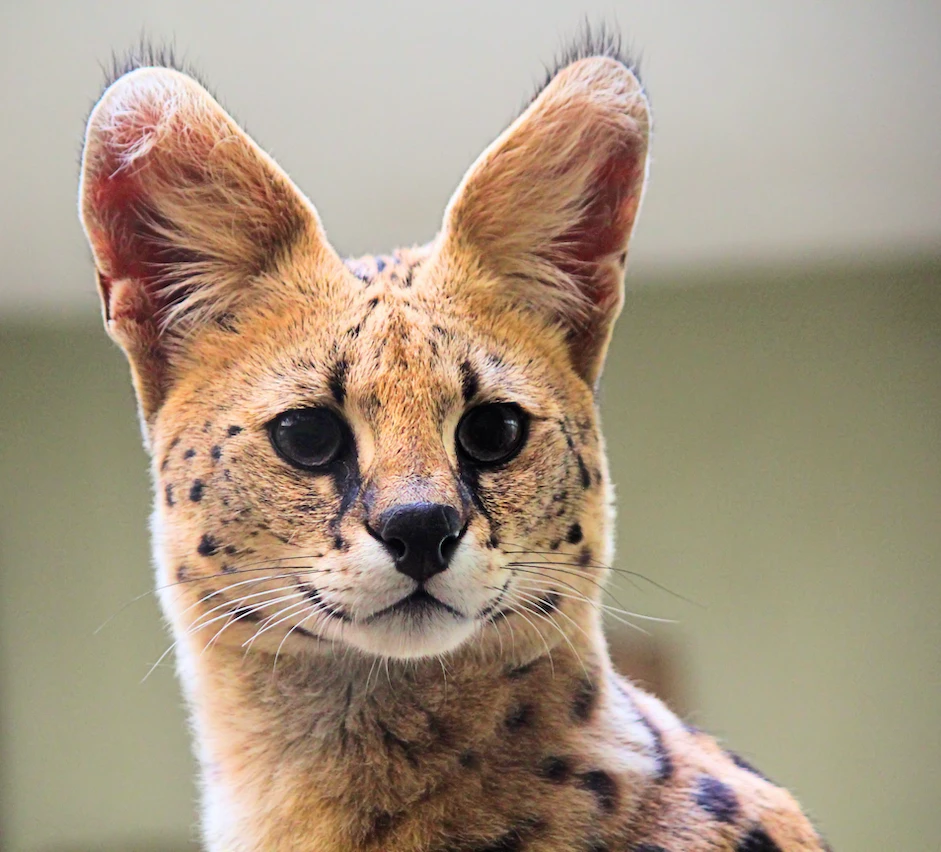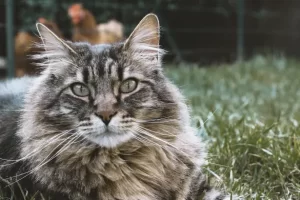Last updated on February 6th, 2023 at 12:52 am

You are thinking about getting a Serval cat as a pet but not sure if this is a good idea? This article will show you some characteristics and behaviors of this animal so that you can determine for yourself if getting a Serval cat as a pet is a good choice.
Currently, there are 19 species of Serval cats in more than 35 countries in the Southern Saharan desert. Serval cats have been facing threats from human beings through poaching and encroachment. There has also been a tough conflict with the humans due to the Serval cats preying on domesticated birds. Their skin, teeth, and claws are worth a lot in the black wildlife market, and their demand in the exotic pet market, makes them more prone to poaching. Luckily, they have not been enlisted as one of the species under the threat of extinction.
Males are typically stronger than females. Serval cat has a small head, huge ears, a golden-yellow to buff coat with coal spots and stripes, and a short, dark-tipped tail. The Serval has the lengthiest legs in the physical appearance of any cat mainly because of the largely stretched metatarsal bones in the feet. Its toes are also lengthened and rarely movable. The coat is primarily brilliant-yellow to buff in color, with numerous dark spots and stripes. The size of the spots varies greatly.
Both males and females define their habitat zones by placing marks on areas with droppings and saliva. Interbreeding occurs at various periods of the year and in multiple sections of their scope, but generally on one occasion or two times a year in a particular region. An offspring of 1-4 is born after a two to three-month incubation period. The kittens are suckled for the first one month and start chasing their prey by themselves at 6 months old. They abandon their mothers when they are about twelve months old.
Characteristics of a Serval cat
- Always Active
The serval cat as a pet is engaged both during the day and at sundown, with action peaking in the wee hours, around sunset, and at midnight. Servals may remain engaged for a prolonged period in chilly or humid conditions. They relax or brace themselves in the canopy of trees and shrubs and grasslands during the blazing midday sun.
- Cautious and strategic
Servals express concern for their surroundings. However, they could be less vigilant if there are no big predators or prey wild creatures are present. Servals can walk up to 4 kilometers or 2.5 miles each night. Servals frequently utilize unique paths to target desired hunting regions.
- They are solitary
Servals are lone animals with hardly cordial engagement other than during the breeding season, when combinations of a different sex may reside together. The mother and her kittens seemed to share the sole lengthy and lasting relationship since the kittens will eventually abandon their mothers when they attain one year old. Both sexes create habitat areas and are particularly engaged within specific locations.
The magnitude of these locations can stretch from 4 to 12 square miles. Prey capacity, vegetation availability, and human influence may all have an impact on the size of the location. Habitat areas may intertwine significantly, but inhabitants socialize minimally. Assertive interactions are uncommon, as Servals seem to avert each other instead of fighting to protect their territories. When two older Servals clash over a particular habitat, a ceremonial showcase may occur where one would position its claws on the other animal’s chest while carefully watching their opponent. This engagement seldom ramps up into a battle.
- Serval cats have aggressive behavior
Aggressive behavior includes upright head motion as opposed to lateral motion in other cats, raising the hair and tail, revealing the teeth and the white band on the ears, and howling. Each of them labels their areas and desired trails by sprinkling urine on neighboring vegetative cover, leaving scats, and brushing their mouths on grassland or the soil surface while expelling saliva.
Feeding habits
The Serval cat is a lone meat eater that hunts both day and night. It hunts rodents, especially rats, small birds, frogs, insects, and reptiles, and uses its listening to pinpoint the prey. It jumps upwards of about 7 feet above the soil surface to catch the prey on its front feet, then ends the prey’s life with a crunch on the head or the neck.
The Servals’ towering legs help them took lengthy jumps on grasslands when predating. They hunt with their eyes and ears rather than with their smelling sense. Their sense of listening is so acute that they can detect subsurface rats and mice. Amid a chase, they would then take a moment and keep their eyes closed to employ this expertise. They would occasionally extend into a hole in the ground to catch prey. One of their primary predating techniques is to wait patiently for a prey’s movement to be heard. They frequently have fun with their meals before consuming them. Servals are incredibly smart cats who enjoy gameplay or brainteasers that make food and everyday activities more enjoyable.
What states allow you to have a Serval cat as a pet
Servals are feral creatures that necessitate a competent, committed owner who could satisfy this cat’s intricate necessities, regardless of if this animal is captured in the jungle or raised in confinement.
In the United States, having a serval cat as a pet is lawful in 16 states. In North Carolina, Alabama, Nevada, and Wisconsin, you may possess a serval without the need for a license. In Texas, Mississippi, Missouri, Oklahoma, Indiana, Pennsylvania, Rhode Island, Maine, Montana, Idaho, North Dakota, and South Dakota, you will need to get a permit. Serval possession is criminal in all the other states. Only when you reside in a state within which it is lawful to possess a Serval and are searching for a credible source for embracing or purchasing a Serval, consult with the Feline Conservation Foundation for further information.
Risks and challenges of owning a Serval cat
Due to their huge size, greater physical activity, and potential to make big jump, having a Serval cat as a pet may be not a good choice for you. It will not only endanger delicate items and electrical wires but also will possibly be hurt or killed by them.
It is very difficult to litter train your serval cat. They have this wild character of marking their territories which you cannot completely eliminate. It is very hard to stop them from urinating in different places of your house. Whatever in the house that they feel like they own, they will urinate on it, including the owner. However, under professional training, this character can be eliminated.
Most people and states do not appreciate it when such a big predator is kept at home. Serval cats, like the other predators, have many legal restrictions such as licensing access. Some states require you to adhere to strict measures and security enforcement which can be very expensive.
A Serval cat often runs into emergency cases as a result of swallowing foreign objects which can be lodged in their throats. They are also greedy feeders. They regurgitate and re-feed on the food. When re-consumption is unsuccessful, it exposes your cat to the risk of choking, and it may need medical attention. Additionally, serval cats require regular deworming and care like other domestic animals which many people are reluctant to treat.
Lastly, serval cats have a long lifespan, unlike other domesticated cats. If your affection for the animal fades over time, you will have a hard time dealing with it. However, if you have a great affection for a serval cat as your pet, you will enjoy your pet friend’s companionship for a very long time. You will have enough time to build a strong bond between your family and your pet.
Is Serval cat friendly toward your guests, your child and other pets?
Even though serval cats are wild animals, I have witnessed a few individuals tame them as pets, and it can be done with proper training. Some Serval cats will be easier to tame if they are adopted by human since being a kitten. Whereas a Serval cat can get along with humans, they are typically one-person creatures. For it to have affection towards your guests, it must be raised among many people so that it gets used to people around it. It is also important for the guest not to provoke it in any way. All animals have a mechanism for protecting themselves when provoked.
When there are children around, you will need to pay close attention to both your Serval pet and your children. A serval cat may hurt the baby, even though it does not intend to. It is a strong animal with predator-like claws and sharp teeth.
For the other pets and animals, when a serval cat is raised among the other pets since its kittenhood, it will not harm them.
Conclusion
Serval cat as a pet is very peaceful when it is well domesticated from its childhood. Exotic animals are gradually getting domesticated. There are many instances in the world where even the big predators are tamed as pets in the homes under governmental license. It is a great chance for people to enjoy the beauty of the wild animals in their homes.
Also read: Is Having Bobcats As Pets Dangerous?


